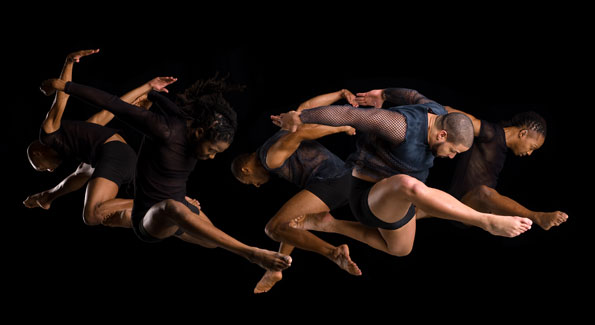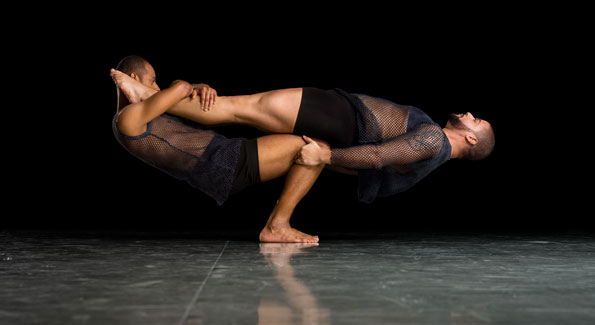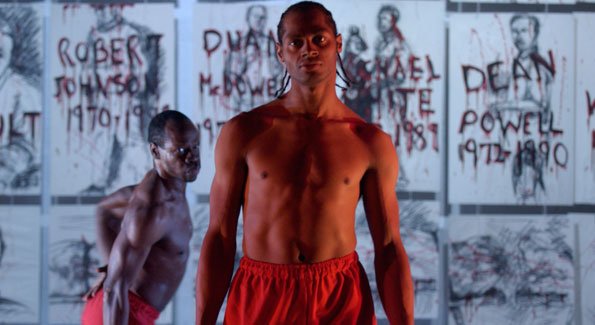Edgeworks Dance Theater embraces the diversity of black male identity.
By Dawn Lim
Raising the political flag through dance is difficult and necessary. Being insistent about a message is not enough to make one eloquent, however.
A showing performed by DC’s all male and largely black Edgeworks Dance Theater at Dance Place this March, had many moments of brilliance and courage, but was too shrill at times in trying to make a statement on black masculinity.
“Snapshots,” choreographed by the company’s founder, Helanius Wilkins, opened with vignettes of a community rife with anxieties. In this sequence, a dancer – completely alone on stage – mimes walking into a club. The pounding music rises to a crescendo, bringing to mind a haze of sweaty bodies and Saturday night love.
He gazes out from a corner like a deer in headlights. In another, a dancer rolls around the ground and reaches out – his movements are an arresting and ambiguous mix of yearning, desire, as well as the thoroughly banal and futile.
In another instance, two dancers meet: the encounter between the two men is fleeting, but pregnant with ambivalence and rivalry.
The sense of competition on stage is quite real, admitted one of the dancers, Nkosinathi “Natty” Mncube. When surrounded by men on the dance floor, the stakes are higher.
“There’s an extra sense of competitiveness when you look at the person in front of you and wonder whether you can jump higher,” he said. But it’s a “healthy rivalry,” he quickly adds.
As the group converges together, inhabiting the space with breathtaking jetes, the sense of combativeness between the dancers feels exhilarating.
A man shadows another, pivots the other over his body and then they face each other, as though for the first time, as equals. Even with its athleticism, the piece’s emphasis on shoulders and torso work accentuate the sense of expressiveness and empathy between the dancers, creating a beautiful connectivity throughout.
The complexities around examining identity from the point of view of the African-American man “sometimes involve embracing a greater diversity to better understand how we are different as much as how we are alike,” said Wilkins, the piece’s choreographer.
Mncube, who was born in Johannesburg, South Africa, says that his earliest memories of dancing involve clapping and stamping out the Gumboot dance, a percussive folk dance done in rainboots.
He claims with some pride that “I never did ballet full out.” Trained at the London Contemporary School of Dance and having worked with a slew of choreographers, Mncube’s more influenced by dramatic European performing modes than the characteristically-American classical aesthetic of Balanchine of many of the other dancers in the company.
In “Trigger” he reclines in a chair and does a brilliant comic satire of masculine prowess. He revels in the dirty pleasures of touching himself, but at the same time, seems shy, idiotic and hyperconscious of performing to an audience.
The parody is ridiculously funny, but troubling. Why is the caricature so funny? Does it actually subvert racial stereotypes, or reinforce it?
While Wilkins’ other works sparkled because of their honesty and ambiguity, another piece, where a child narrates a letter from a father who urges him not to strike out and not be another black statistic, lapses into kitschy sentimentality in an attempt to be heartfelt. In another, the accompanying audio spits out explosive racial slurs and questions the double standards that plague our society.
Yet the bitter bile that surrounds the piece locks it up an anger that seems almost self-limiting on an artistic level.
I found the performance most articulate when it was not trying too hard to be explicit. As this exciting, important company finds its voice, perhaps it will find that stirring the waters doesn’t necessitate speaking the loudest.



